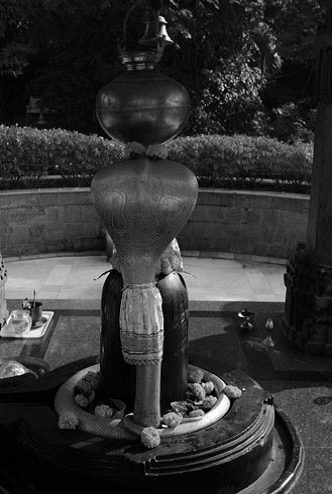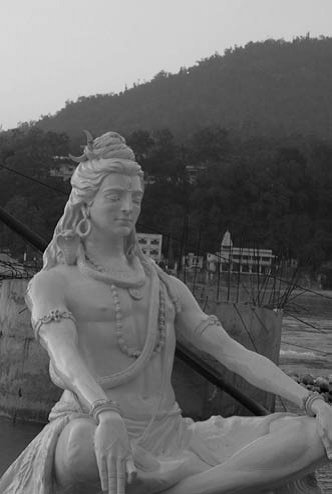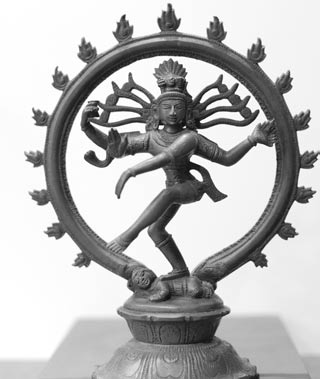
Worship of Śiva as part of Holy Trinity
Śivarātri is celebrated by all Hindus. Many Hindus go to the temple and spend the evening singing devotional songs. Some celebrate it in home temple observing fast and doing prayers. The main places where this festival is celebrated with great pomp are at the twelve Jyotir Lingas—Śiva temples. These are at Kedarnath, Varanasi, Vaidynath, Ujjain (Avanti), Somnath, Dwaraka, Omkareshwar, Trimbakeshwar, Ghrishneshwar, Srisailam, Bhimashankar, and Rameshweram. For Hindus, these are the place for pilgrimage.
Many Hindus believe that Śiva as the life force is the creator of the universe. They believe in the ancient saying, “The creation is neither characterized by Lotus (the emblem of Brahma) nor by the Chakra (the emblem of Vishnu) nor by the Vajra (the emblem of Indra). Therefore, all creations are born of Maheshwara.” (Ganapati: Song of the Self by John A. Grimes)
Ten Praanas and atman are eleven Rudras mentioned by Yajanvalkya in Upanishad. The same are also mentioned in Yajurveda. As ten Rudras and the atman enters a living being, life begins. As these depart, life ends for that person. Rudras being good and mangalmai (auspicious) are known as Śiva or Śivam. Below is the picture of Lord Śiva as Nataraja. In Tamilnadu, India, there is a temple at Chidambaram. It is believed that at this place, Śiva performed the dance of creation. There are beautifully sculpted figures showing 108 postures and mudras (hand gestures) of Śiva’s dance.
Procedure and Ceremony on Śivarātri
Devas are invited. Śiva is invited. Yajna is performed by the community. Offerings are made with chants. Devotees sing devotional music. Ceremony ends with peace prayer. On Śivarātri, Hindus pray to the pillar of light for strength to keep peace within and in the world. Śiva manifested Himself as a pillar of light/ fire. Students may remember that the light in Hindu tradition refers to enlightenment, knowledge, vision, good speech, and wisdom. On the darkest night of the month in February, Śiva appears as the pillar of light to end ignorance. Ignorance gives birth to anger, violence, untruth, conflict, and darkness. All these are dark forces disturbing not only a person’s mental peace, but these forces also destroy peace in the society and in the nation.
Prayers are offered for the well-being of all the people in the world:
Asdo ma sad gamyo, tamso ma joyitir gamyo
Mrityor mam amritam gamyo
Sarve bhavantu sukhinah, sarve santu niramya
Sarve bhadarani pachyantu ma kaschit dukha bhagbhavet
Karpur Gouram karunavtaram, samsara saram bhujgendra haaram,
Sada vasantam, hrideya arvinde, bhavam Bhawani sahitam namami
On Śivarātri, during the prayer ceremony, usually, eleven kalashas (earthen round pots with water) are placed in a circle, symbolizing ten Praanas. The eleventh kalasha, the symbol of the Atman is placed in the middle.
In Kalahasti temple at Varanasi, the puja is performed showing the hand of time moving. In creation, transformation, and destruction, it is the hand of time that carries us forward. Thus, Śiva Linga is that pillar of two tattavas (elements) responsible for the formation of the earth and its atmosphere.
Śivalinga
The most popular form worshipped is the Śivalinga. Śivalinga is the bottomless pillar of light. In the beginning, there was only space; then a lighted pillar appeared—the echo sounded as the vibration of Aum, air (Vayuh) filled the atmosphere. The friction caused fire (Agni). In one of the Yajurvedic mantras, this pillar of light is referred to as Svastambhitam. It is believed that this happened on the day of Śivarātri. Śivarātri, that is, Śiva’s Night, is the famous festival in honor of Lord Śiva. The pillar has no base, for the space has no beginning or end. At best we can compare it with a shooting star. The light appeared and vanished having created the two tattavas (elements of air and fire), essential elements for sustaining life. There is a sculptured fresco of this stambha in the ASI archives. During the Indus-Sarasvati age (5000 BC to 1900 BC), people offered prayers to Śivalinga.
Below is the picture of Śivalinga

Linga means a pillar (stambha)- a pillar of light Linga means a “mark” in Sanskrit. It is a symbol that points to an inference. For he is the life force, the air we breathe. The pillar of light arising from Agni, the fire, and fanned by the pure air makes the shape of Śivalinga. In the evolution of elements, air fills the space followed by fire making the unfathomable base of the pillar, and thus, together they complete the basic sustenance for life on earth. Hindus worship this pillar as Śivalinga, knowing fully well that Śiva is unfathomable and formless. He has no form of his own, and yet all forms are his forms. Śiva is everywhere all the time. Stark and geometric, the linga is meant to represent, in an abstract fashion, a pillar. As a pillar, it stands for Śiva as the axis of existence, which Hindus believe extends from the Absolute to the everyday world. From this axis, the world is born, and it is to this axis that it will return to before complete annihilation at the end of time (end of the kalpa).
“Every form is the form or Linga of Lord Śiva. The Linga is only the outward symbol of the formless being, Lord Śiva—Lord Śiva incarnate, who is the indivisible, all-pervading, eternal, auspicious, ever-pure, immortal essence of this vast universe, who is the undying soul seated in the chambers of one’s heart, who is one’s Indweller, innermost Self or Atman and who is identical with the Supreme Brahman.”
There is also the literary evidence of puja of this stambha in Valmiki’s Ramayana. Ravana prayed to Śiva for a long time, and then he wanted to take him along with the Kailash Mountain. He shook it hard and was able to take an elongated piece of the rock, which he thought was the essence of Śiva’s being. Ravana started the puja of this stambha. Sri Rama also performed puja of this stambha before crossing the ocean. This story is sculpted in part at Kailash cave 16 at Ellora. Worked from top to bottom, the temple happens to be the largest monolithic temple made out of one rock. Ravana’s chariot is also carved. This archaeological evidence also reveals the idea of the Stambha. Long pillar, if constructed needs a base, and the base is in the diya; the combination of Vayu and Agni was thus completed. Artists down the ages created amazing pieces of art using diverse art media. Though early paintings did not survive the ravages of time and the invasions, cave temples, frescoes, rock temples and bronze statues have survived.
Here is another picture of Śiva created by the artists.

Śiva is sitting in yogic posture. The river Ganges is falling from his hair. He has snakes around his neck, blue patch of poison on the throat, moon on his forehead; and his third eye is closed. A yogi is not afraid of the obstacles. In Hindu tradition, snakes usually symbolize worries, negative emotions, temptations, and obstacles. The blue patch on the throat is poison. A yogi digests the good and the bad equally well. Because of the blue patch on his throat, he is also called Nilakantha. The river Ganges is known as Sursari, which means its origin is Devaloka (associated with the cloud system or the atmosphere). The river may not descend with the full destructive force; so Śiva releases it slowly. The abode of Śiva is Mount Kailash in the Himalayas. Snow is the symbol of purity and austerity of mind. Thus, through this symbol, several concepts are connected—the origin of the Ganges from the Himalayas, the rainwater swelling the river and the rain originating from the cloud system. Śiva’s eyes are half closed, which indicates even though he is in meditation, he is aware of the material world. Śiva’s third eye signifies the eye of wisdom. Śiva is worshipped as Śiva and Parvati. He is also worshipped as Nataraja: King of Dance or Simply Dancing Śiva.
Below is another picture of Śiva as Nataraja which symbolizes Kaal and Mahakaal:

Śiva as the king of dance shows the rhythmic cycle of birth, transformation, and death of life. It also signifies that the world as we see today may not be there at the end of the kalpa. Both the Creation and the annihilation are an integral part of all life. The upper right hand has tabor (dummaroo), which symbolizes the sound of creation. The lower right hand is raised in half-moon gesture, the upper left hand has flame of destruction in its palm, and the lower left hand is showering blessings. One leg is raised indicating remaining above the material world, and the other leg presses hard on all that is negative and evil.The late astrophysicist, Carl Sagan (1934-1996) in his book, Cosmos, asserts that the Dance of Nataraja (Tandava) signifies the cycle of evolution and destruction of the cosmic universe. Carl Sagan further says, “The most elegant and sublime of these is a representation of the creation of the universe at the beginning of each cosmic cycle, a motif known as the cosmic dance of Lord Śiva. The God called in this manifestation Nataraja, the Dance King. In the upper right hand is a drum whose sound is the sound of creation. In the upper left hand is a tongue of flame, a reminder that the universe, now newly created, will billions of years from now be utterly destroyed.”
No matter, how we worship, Śiva is the ultimate reality of the cosmic reality as well as the life circle of all life anywhere and everywhere.
–Mrs. Kamlesh Kapur, Author and Educator, USA

Very nice and comprehensive article on Shiva. However, a couple of points, especially as Shiva is presented as a symbolic force of the universe, need clarification. One, Shivaratri is supposed to be the occasion of vivah between Shiva and Parvati. What nay be the symbolic meaning of such an event. Two, there is a concept of different worlds – physical, subtle, and causal. The symbolic supremacy of Shiva is in the physical world.
LikeLike
The explanation of symbolism of Nataraja as the creative, trans-formative and sustaining force is briefly included. The concept of consort is in the Rigveda itself. Shiva being the phenomenon and its force being Parvati. Both consciousness and the material energy create life. The marriage is symbolic. The actual legend is in the Puranik tradition. The friction created by Vayuh produces Agni and the evolution of life began. We worship Linga on Shivaraatri and not their marriage.That pillar of light is Shivalinga which was worshiped by Shri Ram and King Bhagirath (the picture of that ling in Gangotri temple is given here. Sati is mentioned in Ramayana but Parvati is not. Terracotta Shivalinga is even prior to Bhagiratha. So the Puranik legends have inner contradictions. At the physical level, Shiva is Praana of the ten Rudras. Shaivites view as Shiva being supreme and not Vishnu. For scientific understanding, I feel that this is another way of looking at the creative force and its cyclical movement. Rudras work in all three states till Shiva leaves the body and then only Shava remains.
LikeLike
Really informative.
LikeLike